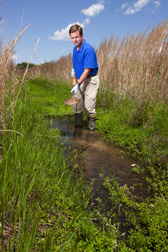 Vegetated drainage ditches can help capture pesticide and nutrient loads in field runoff, U.S. Department of Agriculture (USDA) scientists report. These ditches — as common in the country as the fields they drain — give farmers a low-cost alternative for managing agricultural pollutants and protecting natural resources.
Vegetated drainage ditches can help capture pesticide and nutrient loads in field runoff, U.S. Department of Agriculture (USDA) scientists report. These ditches — as common in the country as the fields they drain — give farmers a low-cost alternative for managing agricultural pollutants and protecting natural resources.Until recently, the primary function of many edge-of-field ditches was to provide a passage for channeling excess water from crop fields. Many farmers controlled ditch vegetation with trimming or dredging to eliminate plant barriers that impede the flow of runoff.
Research by Agricultural Research Service (ARS) ecologist Matt Moore and colleagues, however, suggest that a slower flow has advantages. The scientists evaluated transport and capture of the herbicide atrazine and the insecticide lambda-cyhalothrin for 28 days in a 160-foot section of a vegetated agricultural drainage ditch in Mississippi. One hour after a simulated runoff event, 61% of the atrazine and 87% of the lambda-cyhalothrin had transferred from the water to the ditch vegetation. At the end of the ditch, runoff pesticide concentrations had decreased to levels that were generally non-toxic to downstream aquatic fauna.
Moore has also conducted work in California where vegetated drainage ditches helped mitigate pesticide runoff from tomato and alfalfa fields.
Sources: Agricultural Research Service
Farm Supply
Farm Magazines
Market Watch
No comments:
Post a Comment